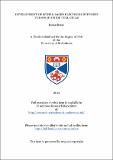Development of spinel-based electrode supports for solid oxide fuel cells
Abstract
The high temperature oxidation of ferritic stainless steel interconnects results in chromium poisoning of the solid oxide fuel cell (SOFC) electrodes, which is a limiting factor for their utilisation as SOFC interconnects. Chromium-rich spinel materials were studied as electrode supports that would be situated at the interface between interconnect and electrode, in order to reduce the effect of chromium poisoning of the electrodes. The main goal of this thesis was to find chromium-rich spinel materials with good electrical conductivity (σ ≥ 0.1 S∙cm⁻¹) in air and reducing atmosphere, chemically and mechanically stable in SOFC testing conditions. The structure and properties of newly formulated chromium-rich spinels, such as Mn₁₊ₓCr₂₋ₓO₄ (x = 0, 0.5), MnFeₓCr₂₋ₓO₄ (x = 0.1, 1), MgMnCrO₄, MnLiₓCr₂₋ₓO₄ (x = 0.1) and MgMₓCr₂₋ₓO₄, (M = Li, Mg, Ti, Fe, Cu, Ga) were studied aiming at their application as electrode support material for solid oxide fuel cells. Cation distributions were determined by Rietveld refinement from X-ray diffraction (XRD), within the limits of XRD precision and correlated with electrical properties determined experimentally. The chemical stability in reducing conditions was studied and the reduction effects upon materials were evaluated by XRD phase analysis and microstructure analysis. It was found that MnMₓCr₂₋ₓO₄ materials have a limited stability to reduction, only MnCr₂O₄ proved to have good stability when reduced, with negative influence for its p-type semiconductor conductivity. Even though MnFeCrO₄ had limited stability to reduction, in reducing conditions the conductivity changed from p-type to n-type semiconductor. A similar behaviour to reduction was observed for MgFeCrO₄. Also the mechanical and chemical compatibility of some spinels with YSZ was studied in terms of thermal expansion coefficient (TEC/K⁻¹), sintering step and possible chemical reactions. Lithium titanate spinels, starting with LiCrTiO₄, were investigated in terms of structure, properties and spinel - ramsdellite phase transition temperature also with the purpose of new material development. For these materials positive results were obtained in conductivity and chemical stability in reducing conditions. The performance of MnFeCrO₄ and MgFeCrO₄ as electrode support materials was investigated when used alone or impregnated with (La₀.₇₅Sr₀.₂₅)₀.₉₇Cr₀.₅Mn₀.₅O₃, La₀.₈Sr₀.₂FeO₃, Ce₀.₉Gd₀.₁O₂, CeO₂ or Pd. Composite anodes for SOFC were prepared by aqueous infiltration of nitrate salts into porous MnFeCrO₄ and MgFeCrO₄ scaffolds and studied by electrochemical impedance spectroscopy (EIS) in symmetrical cell configuration. The performance of the composite anodes was evaluated in humidified 5%H₂/Ar in order to understand their stability and performance at 850 °C or lower temperature with respect to the porous substrates. It was found that all the impregnated phases adhere very well to the spinel and considerably enhance performance and stability to a level required for SOFC applications. An interesting next step in this work would be to apply such spinel materials on steel interconnects, integrate them into testing SOFC devices and evaluate their effect upon chromium poisoning of the electrodes.
Type
Thesis, PhD Doctor of Philosophy
Collections
Items in the St Andrews Research Repository are protected by copyright, with all rights reserved, unless otherwise indicated.

